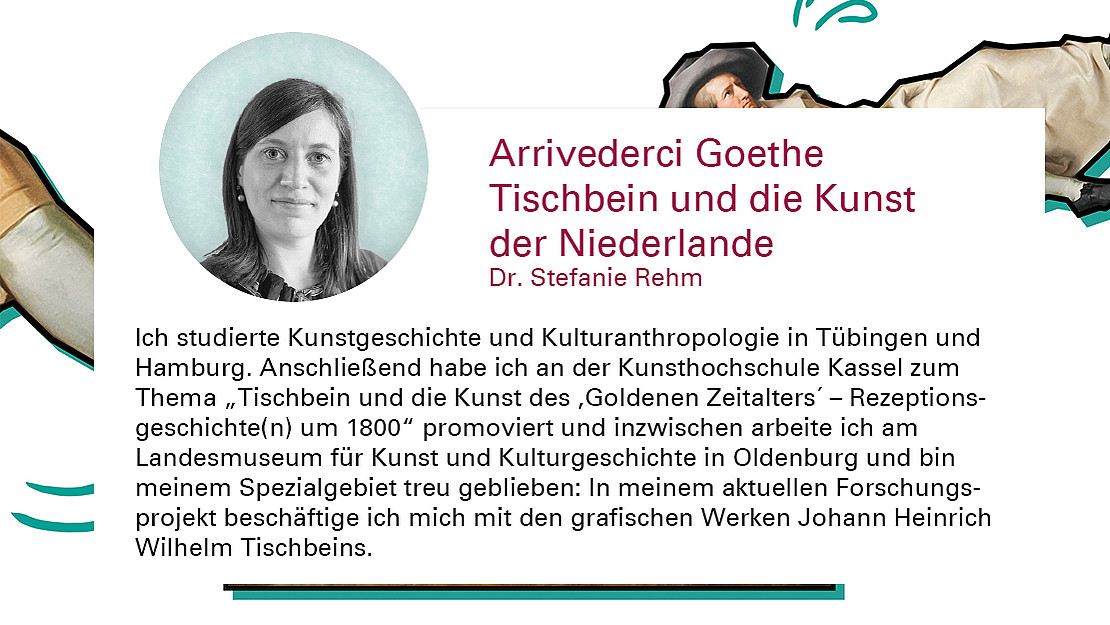This page contains automatically translated content.
Arrivederci Goethe Tischbein and the art of the Netherlands

A single painting made Johann Heinrich Wilhelm Tischbein (1751-1829) world-famous: his depiction of Johann Wolfgang von Goethe in the Roman Campagna is probably the most famous portrait of the poet prince and earned the artist the nickname "Goethe-Tischbein". This is certainly helpful in categorizing the painter. After all, around 30 artists from three generations belong to the Tischbein dynasty. However, reducing Johann Heinrich Wilhelm Tischbein's personality and work to a single oeuvre in no way does it justice. His graphic oeuvre is just as impressive as his detailed notes on Dutch art, which he studied intensively during a journey in 1772/73.
The aim of my dissertation at the School of Art and Design in Kassel was to investigate the reception of Dutch art around 1800 in Germany - and Johann Heinrich Wilhelm Tischbein is a wonderful example of this. During his one-year stay in the Netherlands, he visited a large number of private collections, auctions and exhibitions and came into contact with collectors and art dealers. These were encounters that made a deep impression on him. His "memoirs", which he recorded in his later years and in which he devoted the greatest attention to Dutch art, show just how much.
Tischbein had good powers of observation and an excellent memory, which is the only way to explain the wealth of detail with which he recorded his impressions even decades after the journey: he described numerous works by Dutch painters - including Rembrandt van Rijn and Philips Wouwerman - in detail and defined the most important characteristics of art from the "Golden Age". He also gave a vivid account of the practices of important art collectors. How did they select the paintings? Who were their regular guests and which artists, in his opinion, belonged in a classic Dutch cabinet? Tischbein's stories testify to his deep admiration and provide valuable information - for art historians and historians alike.
The influence of Dutch art on the life and work of Johann Heinrich Wilhelm Tischbein had never before been studied scientifically. This made it all the more exciting for me to delve into the memories of his trip to the Netherlands piece by piece. Much of the material available to me for my research project came from the State Museum of Art and Cultural History in Oldenburg, where Tischbein once worked as court painter to Duke Peter Friedrich Ludwig. I found further documents in the estate of Carl Georg Wilhelm Schiller in the Braunschweig city archives and in the archives of the Museumslandschaft Hessen Kassel.
Three places, one elaborate research project: collating information and quotations therefore often resembled a gigantic puzzle. But it was precisely this detective work that I found particularly appealing. With each new discovery in Tischbein's extensive estate, the picture of the artist became more differentiated. My findings show that he was much more than the painter who traveled Italy together with Goethe. He was also a chronicler and art connoisseur who makes the history of the reception of Dutch art around 1800 more tangible for us.
However, my dissertation is by no means the end of Tischbein research for me: I now work at the State Museum of Art and Cultural History in Oldenburg, where a large part of Johann Heinrich Wilhelm Tischbein's estate is located. Here I am curating the special exhibition "Excellent Dutchmen - The Oldenburg court painter Tischbein and Dutch art". I am also devoting a two-year projectexclusively to Tischbein's graphic works, which have also rarely received attention in art history. The unedited collection comprises a total of 1500 drawings, watercolors and prints - from roughly sketched figures and detailed portrait studies to colorful depictions of animals and fable illustrations. Making these works accessible and assigning them to Tischbein's numerous artistic and literary projects is a task that is as exciting as it is challenging.
Goethe will not play a role in this research project either. And who knows, perhaps Johann Heinrich Wilhelm Tischbein will one day step out of his shadow and be perceived as the multifaceted artist he was.
Dr. Stefanie Rehm (35) studied art history and cultural anthropology in Tübingen and Hamburg. She then completed her doctorate at the School of Art and Design in Kassel on the subject of "Tischbein and the Art of the 'Golden Age' - Reception History(ies) around 1800". Rehm now works at the State Museum of Art and Cultural History in Oldenburg and has remained true to her area of specialization: In her current research project, she is looking at the graphic works of Johann Heinrich Wilhelm Tischbein.